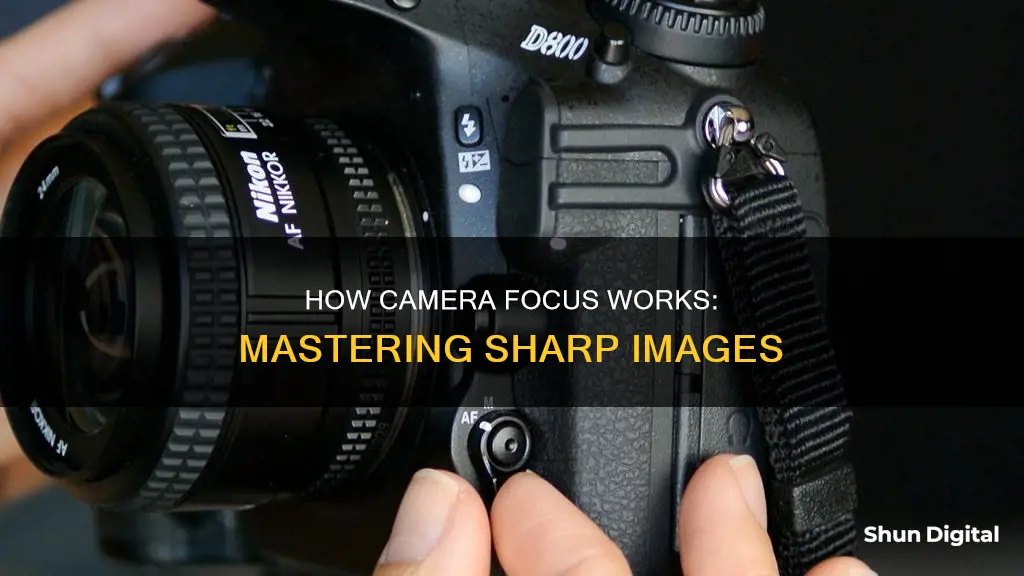
Focusing is a critical skill for photographers to master. It involves making adjustments to the lens to achieve the maximum sharpness and contrast for a chosen subject. This can be done manually or through autofocus.
Manual focus involves physically adjusting the focus ring of the lens, and is useful when the camera struggles to focus or when taking a series of images where focus must remain constant. Autofocus, on the other hand, is a more recent invention, where a motor in the camera or lens automatically adjusts the lens to focus on a chosen subject.
Different types of cameras have different focus systems, and it's important to understand how they work to achieve the desired results. For example, DSLR cameras often use phase detection autofocus, which is very fast and great for tracking moving objects, whereas mirrorless cameras, point-and-shoot cameras, and DSLRs in live view mode tend to use contrast detection autofocus, which is slower but more precise, making it better suited for product or landscape photography.
Additionally, there are different autofocus modes available, such as single-servo and continuous-servo, which are more suitable for different scenarios. Single-servo autofocus locks the focus on a single subject and only refocuses when the subject moves or the photographer adjusts the focus, while continuous-servo autofocus continuously adjusts focus as long as the focus button is held down, making it ideal for tracking moving subjects.
Ultimately, the choice between manual and autofocus, and the various autofocus modes, depends on the specific situation and the photographer's preferences. Both have their advantages and can help create visually pleasing and impactful photographs when used effectively.
| Characteristics | Values |
|---|---|
| Focus type | Manual, Autofocus |
| Autofocus type | Phase detection, Contrast detection |
| Autofocus mode | Single-servo, Continuous-servo, Auto-servo |
| Autofocus area mode | Single-point, Dynamic-area, 3D-tracking, Group-area, Auto-area |
| Focus button | Shutter button, Back button |
What You'll Learn

Manual vs Autofocus
Modern cameras are designed to autofocus an image in most circumstances. However, photographers may prefer to manually focus their images in certain situations.
Manual Focus
Manual focus is when the user sets the point of focus in an image. This mode is generally used for still images, such as in landscape, portrait, or macro photography. It is also useful when shooting in low-light conditions or when shooting through glass or wire fences.
Manual focus is preferred for macro photography as it allows the photographer to be incredibly precise with focusing. It is also useful for shooting portraits, as the eyes need to be in perfect focus.
Manual focus is also beneficial when shooting in low-light conditions. Autofocus systems depend on light to determine where to focus and therefore perform poorly in low-light conditions.
Autofocus
Autofocus is when the camera sets the point of focus in an image. Autofocus is generally quicker than manual focusing and is more suitable for action scenarios, where objects are moving, such as in sports photography.
Autofocus systems rely on contrast to identify objects. When this contrast is not present, such as in low-light conditions or when there are many objects in the scene, the ability of the autofocus system to focus is impeded.
Autofocus is also beneficial when shooting in low-contrast scenes. When there is heavy backlight, the ability of the autofocus system to focus is severely impeded.
Best Battery Adapters for Moultrie Cameras: Power Options Explored
You may want to see also

Autofocus Area Modes
Autofocus (AF) area modes are a feature of modern digital cameras that help fine-tune how and where the camera focuses within a scene. The right autofocus mode can make or break your shot.
Single-Point AF Area Mode
Single-point AF area mode allows you to select a single focus point for static elements within the scene. As long as you keep the subject framed over this point and are using AF-C, the camera will automatically adjust the focus to keep the sharpness of the image.
Dynamic AF Area Mode
Dynamic AF area mode allows you to manually select your focus point. If the subject moves, your camera uses the selected point as well as the surrounding points to keep the subject sharp. Most cameras include different dynamic AF area modes in groups of several focus points, like 9, 21, or 51.
Group AF Area Mode
Group AF area mode allows you to select a specific autofocus area with a small number of autofocus points to focus on rather than a single point. It is ideal for wildlife and sports photography where there are subjects in groups in a specific area.
Auto AF Area Mode
Auto AF area mode is completely automatic. This is the best focus area mode for letting the camera decide which focus points to use for a given scene. The main difficulty with the auto AF area mode is that the camera has the most control over which part of the scene it deems important.
Camera Battery Drain: Quick Fix Tips
You may want to see also

Phase Detection vs Contrast Detection
Phase detection and contrast detection are the two autofocus systems used in modern digital cameras. The autofocus system your camera uses makes a big difference to its effectiveness.
Phase Detection
Phase detection autofocus (AF) is the system most commonly found on today's DSLR cameras. It is also used by some mirrorless cameras in continuous autofocus mode to improve AF tracking accuracy.
In an SLR camera, light passes through the lens, hits a reflex mirror and is reflected up through a prism and out through the viewfinder. The centre of the camera's mirror is translucent, and a sub-mirror behind it reflects light down into the base of the camera body, where the AF sensor unit is positioned. This is the heart of the phase detection AF system.
The AF unit contains a sensor that corresponds to the camera's AF points. Phase detection works by dividing the incoming light into pairs of images and comparing them. If the images hit two lines on the AF sensor precisely, the subject is in focus. The distance between the two images tells the camera how much the lens is out of focus. The AF unit then works out how far to move the lens to bring the subject into focus.
Phase detection AF is fast and precise, making it ideal for tracking fast-moving subjects. However, it doesn't work as well in low light and may struggle with low-contrast subjects. It also can't put AF points close to the edge of the frame as the edges are always darker than the centre at the widest aperture. Phase detection is also prone to errors when focusing with wide apertures as it is a partly mechanical process.
Contrast Detection
Contrast detection AF is used by mirrorless cameras, point-and-shoot cameras, DSLR cameras in live view and smartphone cameras. It uses the light falling on the main sensor to provide focus. This gives contrast detection the advantage of offering an almost unlimited number of focus points.
Contrast detection works by analysing pixels on the camera's sensor. It works on the basis that the subject is in focus when contrast is highest. To find that point, the camera has to constantly evaluate images and push the focusing point of the lens back and forth. As a result, contrast detection AF is slower than phase detection. However, it is far more accurate at focusing on still subjects and there is no need to calibrate your lens as there are no mechanical focusing errors.
Phase detection AF is generally faster and more suitable for wildlife or sports photography, or anything that uses the AF tracking and continuous focusing abilities of your camera. In contrast, contrast detection AF is more accurate and more flexible, making it a better option for portrait photography.
Some cameras use a hybrid of the two systems. For example, a digital SLR camera may use contrast detection AF in live view or movie mode and phase detection AF when you look through the viewfinder.
Polaroid Snap Camera: What Battery Type?
You may want to see also

Continuous vs Single-Servo Autofocus
Single-servo autofocus and continuous-servo autofocus are two of the main autofocus modes available on most professional cameras. They are also referred to as single autofocus and continuous autofocus, respectively.
Single-servo autofocus is used for photographing static scenes or subjects that are not moving. When using this mode, the camera will focus on the subject once and lock the focus until the photographer takes their finger off the shutter release button or captures the image. This mode is useful when motion is not a major factor and when the depth of field is not critically shallow.
On the other hand, continuous-servo autofocus is designed for shooting moving subjects. In this mode, the camera tracks the subject's movement and continuously adjusts the focus to keep the subject sharp, even if the photographer or the subject is moving. This mode is particularly helpful when shooting at super-shallow apertures or at close distances, as even the slightest movement can cause the subject to go out of focus.
Different camera manufacturers have different names for these autofocus modes. For example, Canon calls single-servo autofocus "One Shot" and continuous-servo autofocus "AI Servo". Similarly, Sony refers to them as "Single-Shot AF" and "Continuous AF", while Nikon uses "AF-S" and "AF-C".
It is important to note that the specific features and behaviours of these autofocus modes may vary slightly between different camera models and manufacturers.
Camera Battery Lifespan: How Long Does It Last?
You may want to see also

Where to Focus
Deciding where to focus in a photograph is a creative decision. The focus of a photograph determines where the viewer's attention will fall. Focusing on a particular part of the image can also be used to hide unwanted parts of the frame.
When taking a portrait, it is generally recommended to focus on the subject's eyes. However, focusing on other parts of the body, such as the nose or ear, can also create interesting effects.
For landscape photography, a small aperture (e.g. f/8 to f/16) will usually be used to ensure that the entire scene is in focus. However, a wide aperture (e.g. f/1.4 to f/4) can be used to create a soft bokeh effect in the foreground.
For wildlife photography, a wide aperture is often necessary to let more light hit the camera sensor, allowing the use of faster shutter speeds. Focusing on the animal's eyes is typical, but focusing on other parts of the body or the surrounding area can also create interesting compositions.
For still life photography, focusing on the right point and using the bokeh effect can enhance patterns and textures in the image.
When photographing fast-moving subjects, continuous autofocus mode is generally recommended. This mode automatically refocuses on the subject each time it moves, as long as the shutter button is half-pressed.
Colorado Camera Tickets: Do You Have to Pay?
You may want to see also
Frequently asked questions
Focus in photography is the process of adjusting the lens to find maximum detail and sharpness in an image. This can be done either manually or automatically.
There are two main types of focus: manual focus and autofocus. Manual focus involves physically adjusting the lens to change the focus distance, while autofocus uses a motor in the camera or lens to automatically adjust the focus.
Autofocus systems use a motor to move elements in the lens to change the focus. There are two main types of autofocus: phase detection and contrast detection. Phase detection is faster and better for tracking moving subjects, while contrast detection is more precise and better suited for still subjects.
The two most common autofocus modes are single-servo and continuous-servo. Single-servo autofocus locks the focus once the subject is in focus, while continuous-servo continuously adjusts the focus as long as the focus button is held down.
The choice of focus mode and autofocus mode depends on the type of photography you are doing. For example, manual focus is often used for still life or landscape photography, while continuous autofocus is commonly used for sports or wildlife photography.







